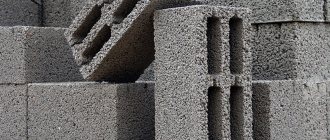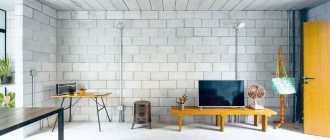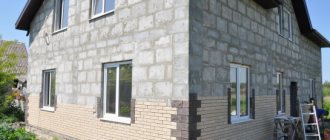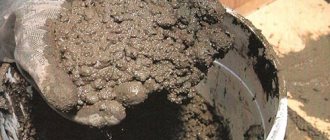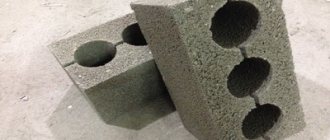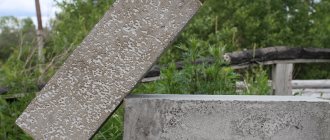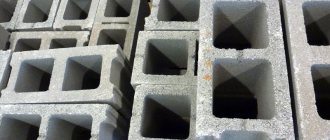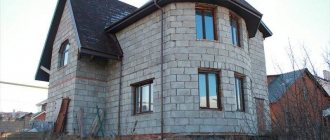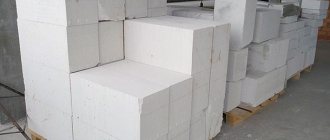Wood concrete is a modern building material from which reliable and durable houses are built. Particularly noteworthy is the thermal conductivity of wood concrete, which even exceeds the performance of the “champions” in this area - foam and aerated concrete blocks. In addition, such products have excellent strength and are quite easy to install yourself. And all these wonderful properties are wrapped in a shiny package that attracts an attractive price, allowing you to significantly save on building a house. All this is guaranteed by manufacturers and sellers of wood concrete, singing the praises of their product. But are they true or are they just advertising gimmicks?
Composition and characteristics
Arbolite is a light, strong, durable and environmentally friendly material. It consists of wood chips, Portland cement and organic additives. Arbolite - thermal conductivity is 0.07-0.17 W/mK, 90 percent consists of wood.
In the form of fillers, according to the rules of the technological process, the following is added:
- coniferous and hardwood chips;
- cotton stalks;
- fire flax;
- rice straw.
To ensure that the products last a long time, contact of the material with water is not allowed. The chips are additionally processed with a specialized compound. The following are used as additives:
- aluminum chloride;
- aluminum sulfate;
- calcium chloride.
Advantages and disadvantages
Like most materials, wood concrete has its advantages and disadvantages. The advantages include:
- environmental friendliness, high thermal insulation performance, light weight. According to these characteristics, it is practically similar to wood, but, unlike it, it is practically not flammable and does not rot;
- Due to the low density and low mass, when building houses from wood concrete, it is possible to use lightweight foundation options - columnar and shallow-buried, which significantly reduces the overall cost of buildings;
- The material is highly manufacturable - it is easy to saw, cut, drill, you can drive nails into it and tighten self-tapping screws.
Learn more about the advantages of arboblocks in the video below:
The main disadvantages of wood concrete are low load-bearing capabilities and high moisture absorption rates. In this regard, wood concrete structures cannot be used in multi-story construction, or as load-bearing walls under concrete floors. The walls also need reliable waterproofing - both at the points of contact with the foundation and along the entire outer perimeter.
Thermal conductivity index of arbolite blocks
The most important parameter for the construction of a building is the thermal conductivity coefficient of wood concrete ?, which determines the amount of heat penetrating into the room through a surface of unit length and area per unit time. The lower the value, the better the thermal insulation.
The heat capacity of wood concrete is the property of blocks to absorb and retain heat. Its value is 2.3 kJ/kgK, so a structure made of this material will heat up faster.
Strength depends on the density of the material. The lower the indicators, the more the bearing capacity of the blocks suffers. Therefore, when choosing a product for the construction of a facility, you need to choose the optimal density. So that during the operation of the building, the specified load-bearing loads are maintained and heat is retained as much as possible.
Water absorption by wood concrete is 75-85 percent. Therefore, the material is often used in the construction of baths. The façade of a structure made from such blocks must be plastered.
Blocks are destroyed as a result of freezing water in the voids. The more water accumulates, the less frost resistance, which affects the service life.
Advantages of using wood concrete in the construction industry:
- Not exposed to fire.
- Absorbs sound well.
- Convenient for technological processing.
- It is plastic, has good bending strength values.
Disadvantages of wood concrete
From the characteristics described above, we can conclude that wood concrete is an excellent material for construction, which combines the key advantages of all wall materials. But he's not perfect. And notes of negative qualities are woven into the overall ensemble of positivity:
- high popularity gives rise to huge demand, therefore, among offers for the purchase of this material, it is quite difficult to find worthwhile ones offering truly high-quality products;
- Even if you manage to find “high-quality” wood concrete blocks, their geometry will still leave much to be desired. Surface unevenness forces thick masonry joints to be made, leading to freezing of the walls, and replacing concrete masonry mortar with perlite mortar affects the final cost of construction;
- mandatory installation of “breathable” facade finishes that do not interfere with natural vapor permeability. Therefore, before insulating a house, you need to study this issue in detail;
- high price. Despite the low number of components and the relatively small price tag of the main filler, the cost of wood concrete is impressive. It is increasing due to undeveloped technology and lack of specialized equipment.
As you can see, the characteristics of wood concrete are closely related, and its thermal conductivity directly and indirectly affects the quality of the future structure.
Thermal conductivity of blocks depending on density
Wood concrete products are divided into two groups: thermal insulation and structural. The density of the material depends on the quality and size of the chips, as well as on the filler used for production.
A comparison of the thermal conductivity of wood concrete is given in the table.
| Type of wood concrete | Average density when using wood filler, kg/m3 | Thermal conductivity index when using wood filler, W/m3 | Average density when using hemp fire, kg/m3 | Thermal conductivity index when using hemp fire, W/m3 |
| Thermal insulation | 400-650 | 0,08-0,13 | 400-650 | 0,04-0,09 |
| Structural | 500-850 | 0,11-0,14 | 550-700 | 0,07-0,1 |
The thermal conductivity of a material depends on density: the higher the density, the worse the properties.
Release forms
The main forms of release in which wood concrete is supplied to the market are blocks and slabs-panels. Depending on the percentage of wood chips and concrete, the characteristics of wood concrete structures can vary significantly:
- According to its density, wood concrete is divided into grades from M-5 to M-50;
- Depending on the strength indicators, it can be of 4 classes from B-0.75 to B-2.5.
Each of these classes has its own purpose and scope: from use as thermal insulation to the construction of load-bearing walls of buildings:
- Wood concrete blocks and slabs with a density of up to 500 kg/m3 are classified as thermal insulation.
- Denser materials, with a specific gravity of more than 500 kg per cubic meter, are classified as structural and are intended for the construction of load-bearing walls and partitions.
Blocks
The most common block sizes are length 500 mm, height 200 mm, with a width from 100 to 500 mm.
Due to the large number of handicraft industries, the dimensions of the blocks vary widely, so when purchasing building materials, it is better to do so from one manufacturer.
The consumption of wood concrete blocks per 1 m3 of wall depends on its dimensions. So, a block measuring 60x20x30 cm has a volume of 0.036 cubic meters. Accordingly, a cube contains about 28 pieces of such blocks, that is, to build 1 m3 of wall, much fewer blocks are required than bricks.
The weight of one block, depending on its size and density, can vary from 10 to 60 kg.
The blocks can be solid or hollow - the latter option is more often used as insulation, because has low thermal conductivity and weak load-bearing abilities.
Panels
Wood concrete panels are much more technologically advanced than blocks. The installation of wood-concrete slabs is carried out much faster than laying a block wall. Among the disadvantages of panel structures:
- the impossibility of casting them at home;
- the need to involve lifting mechanisms in construction and installation work - due to their heavy weight, it is impossible to install wood concrete slabs without the help of a crane or winch.
There are different sizes of slabs: from small ones with a length of 80 cm, a height of 60 and a thickness of 30 cm, to real wall panels with dimensions of 230x120x30 cm.
The maximum dimensions of wood-concrete panels are limited by the strength of the material: the maximum length of the slab should not exceed 2.5 m with an aspect ratio of 1:2.
In private buildings, a monolithic pouring technique can be used, when the finished wood concrete mortar is poured directly into the formwork at the construction site.
Analysis of building blocks from various materials
To choose the best material for the construction of a building, it is necessary to compare the indicators. Comparative characteristics of the thermal conductivity of building materials are given in the table.
| Material | Thermal conductivity, W/m K | Density, kg/m3 | Frost resistance, cycles |
| Arbolite blocks | 0,08-0,17 | 400-850 | 25-50 |
| Foam concrete blocks | 0,14-0,38 | 200-1200 | 35-75 |
| Aerated concrete blocks | 0,18-0,28 | 600-800 | 35-80 |
| Expanded clay concrete blocks | 0,5-0,7 | 900-1200 | 25-50 |
| Cinder blocks | 0,2-0,6 | 900-1400 | 15-50 |
| Brick | 0,56-0,95 | 1550-1900 | 15-50 |
| Wooden beam | 0,15-0,32 | 450-600 | 25-100 |
When giving preference to an arbolite block, you should remember the disadvantages:
- high water absorption;
- foundation waterproofing required;
- not intended for the construction of tall buildings.
The material is suitable for the construction of objects in noisy areas with large temperature differences.
Thermal conductivity
Average density 400-850 kg/m3
Due to the light weight of the blocks, no class="fa fa-angle-down"> is required
This indicator allows the wall made of wood concrete to withstand seasonal fluctuations of the foundation without destruction or cracks. This is also another indicator that allows you to make shallow foundations. Thermal conductivity and heat capacity are two main indicators, which we will discuss in more detail at the end of the article.
Frost resistance, 25-50 cycles - with this indicator we will turn to GOST 19222-84 and GOST 7025-91.
How is frost resistance tested?
The test sample is placed in a freezer with a temperature from minus 15 to minus 20 °C. One freezing and subsequent thawing constitute one cycle. The loss of strength of samples tested for frost resistance should not exceed 15% of the strength of control samples not subjected to frost resistance testing, and the loss of weight should not exceed 5%. With proper use of the house, provided that the walls are not subjected to heavy moisture, wood concrete walls will serve you for decades, or even a hundred years.
Water absorption, 40-85% - This is the same indicator with which they “scare” the consumer and call it the most important disadvantage of wood concrete.
Let's try to understand this issue.
Indeed, due to the porous structure of wood concrete, it absorbs moisture very well.
But for some reason no one says that it also gives off this moisture well? A reasonable question arises - if wood concrete absorbs and releases moisture well, then it will absorb moisture from the street and transfer it into the room, which means the room will always be damp. This conclusion would be correct if not for one “BUT”! According to instrument readings, the pressure inside the house is always slightly higher than the pressure outside. Therefore, wood concrete takes moisture from the room and releases it outside, and not vice versa. This property of arbolite walls is why they say that the house “breathes.” This is why there is no dampness in arbolite houses!
Shrinkage, 0.4-0.5%
Everything is clear here. A house made of wood concrete practically does not shrink, unlike the same wood, which makes it possible to carry out all the finishing work almost immediately.
Biostability - Group V
This is also a very important indicator. According to research by scientists, it has been established that the susceptibility of wood concrete to fungi is an ORDER of magnitude lower than that of the wood from which it is made. There are no contradictions here either. We envelop the wood chips with a chemical composition, and don’t let the word “chemical composition” scare you. The chemicals we use react with the sugars that are present in the tree, neutralize them, then precipitate and no release of harmful substances occurs. This chemical is also used to purify drinking water. And cement itself is a good antiseptic.
Fire resistance - 0.75-1.5 hours.
This indicator means that 15 minutes after the fire, you will not be able to fry shish kebab on the coals of your home. Arbolite does not support combustion. Here is an excerpt from scientific works. ... “The fire tests of a full-scale fragment of a building made of arbolite volumetric blocks, carried out by the Kyiv Fire-Technical Station, are of interest. During the test, a two-story fragment of four blocks was loaded with a standard static load characteristic of a three-story building. In one of the blocks on the first floor, an experimental fire was created by burning stacks of wooden slats (50 kg per 1 square meter of floor area). The building fragment did not collapse during a fire that lasted more than 1 hour, and after cooling it withstood double the standard load.”
Sound absorption, 126-2000 Hz - 0.17-0.6
This indicator indicates that wood concrete has very good sound insulation.
Now we want to return to two characteristics that we promised to talk about at the end of the article.
The thermal conductivity of wood concrete is 0.08-0.17 W/(m x °C).
Thermal conductivity is a quantitative characteristic of a body's ability to conduct heat.
Quantitatively, the ability of a substance to conduct heat is characterized by thermal conductivity coefficient
. This characteristic is equal to the amount of heat passing through a homogeneous sample of material of unit length and unit area per unit time at a unit temperature difference (1 K). The SI unit for thermal conductivity is W/(m K).
What does this characteristic give us?
The low thermal conductivity of wood concrete compared to brick, expanded clay blocks, and foam blocks makes it possible to reduce material costs for construction, since no additional insulation of the walls is required. The wall thickness of 40 cm corresponds to the most stringent SNIP standards in terms of thermal conductivity. The small thickness of the walls allows you to increase the living space of the house without additional costs. This could be the end of the description of the characteristics of wood concrete, but there is one more indicator, or rather even two indicators, that other manufacturers of wall materials never mention - heat capacity and heat absorption. The first indicator is heat capacity.
We believe that this is generally one of the most important indicators of the properties of any material.
Heat capacity is the property of a material to absorb heat when heated, and to release it when cooled. An indicator of heat capacity is specific heat capacity. Due to their chemical nature, some materials are able to transfer energy while remaining stable, while others can accumulate it until their destruction. In other words, inorganic substances are heat conductors, and organic substances are heat stores or insulators
.
The indoor climate is significantly determined by the heat capacity of the material. The high heat capacity of wood concrete leads to an even indoor climate, as strong temperature fluctuations (day-night, weather changes) are reduced. Modern building materials have higher thermal resistance than traditional materials. This allows you to make walls thinner, which means cheaper and lighter. All this is good, but thin walls have less heat capacity (see table), that is, they store heat less well. You have to constantly heat it - the walls heat up quickly and cool down quickly. The table below shows the comparative characteristics of the heat capacity of concrete, expanded clay concrete, and foam aerated concrete. With different thermal conductivities from 1.5 W/(m •°C) for concrete and 0.14 W/(m •°C) for foam-aerated concrete, the heat capacity of these materials is absolutely the same and amounts to 0.84 kJ/(kg• °C). We especially want to pay attention to fiberglass insulation!
They are mainly used to insulate the external walls of buildings. The thermal conductivity of such insulation is 0.046 W/(m•°C), but the heat capacity is the same as that of concrete – 0.84 kJ/(kg•°C). Therefore, talking about the high energy-saving properties of this material can only be a stretch.
What is the significance of the heat capacity coefficient during the operation of a building?
The heat capacity of the air is slightly more than 1 kJ/(kg•°C), so at first the air, when heated, will give off heat to walls made of brick, expanded clay blocks, foam and gas blocks, since they have a lower heat capacity, and only after heating the walls will they begin to give off heat indoor air. In houses made of wood concrete, the room is immediately heated, since the heat capacity of wood concrete is 2.5 times higher than air, and it will not take away internal heat. In cold areas with unregulated autonomous heating systems, this characteristic is of great importance for maintaining stable thermal conditions in the premises. The table below shows that a wall built from arbolite blocks has 2 times higher heat capacity than a wall made of polystyrene concrete comparable to it in terms of thermal insulation, and 3 or more times than a wall made of expanded clay concrete, foam aerated concrete, or brick.
Thermal properties of building materials (SNiP II-3-79)
| Name of material | Density | Specific heat | Coefficient of thermal conductivity |
| Concrete | 2400 | 0,84 | 1,510 |
| Reinforced concrete | 2500 | 0,84 | 1,690 |
| Expanded clay concrete | 600 | 0,84 | 0,160 |
| Air | 1,29 | 1,005 | 0,026 |
| Foam-aerated concrete | 600 | 0,84 | 0,140 |
| Foam-aerated concrete | 800 | 0,84 | 0,210 |
| Polystyrene concrete | 500 | 1,06 | 0,125 |
| Polystyrene concrete | 600 | 1,06 | 0,145 |
| Lime-sand mortar | 1600 | 0,84 | 0,470 |
| Drywall | 800 | 0,84 | 0,150 |
| Ceramic brick | 1400 | 0,88 | 0,410 |
| Silicate brick | 1800 | 0,88 | 0,700 |
| Pine, spruce along the grain | 500 | 2,30 | 0,180 |
| Pine, spruce across the grain | 500 | 2,30 | 0,090 |
| Arbolit on Portland cement | 600 | 2,30 | 0,110 |
| Tow | 150 | 2,30 | 0,050 |
| Stitched glass fiber mats and strips | 150 | 0,84 | 0,061 |
| URSA glass staple fiber mats | 15 | 0,84 | 0,046 |
| Expanded polystyrene | 150 | 1,34 | 0,050 |
| Foam plastic PVC-1 and PV1 | 125 | 1,26 | 0,052 |
| Window glass | 2500 | 0,84 | 0,760 |
| Construction sand | 1600 | 0,84 | 0,350 |
And the second, no less important indicator of the material is heat absorption.
Heat absorption is the ability of a material to absorb heat in contact with other materials.
If we stand barefoot first on a wooden floor, and then on a tiled or concrete floor, we will feel that the wooden floor is warmer, although the temperature on the surface of the floor - concrete, tiled or wooden - will be the same.
This is due to the significant heat absorption of concrete and tiles, and the fact that the human body reacts not to the ambient temperature, but to the intensity of heat transfer from the body. Therefore, an arbolite house will never take away the thermal energy of your body. This is another one of the unique properties of wood!
In addition to the above properties, wood concrete is also excellent at sawing and cutting, it is easy to hammer nails into it and screw in self-tapping screws.
Leading manufacturers
In Russia, wood concrete began to gain particular popularity at the turn of the 20th and 21st centuries, with the beginning of mass low-rise construction.
Thanks to the availability of raw materials and simple production technology, many companies today are engaged in the production of wood concrete structures. The largest manufacturers on the domestic market are:
- "Arbolit Eco" is a manufacturing company located in the Noginsky district of the Moscow region. Engaged in the production of blocks, design and construction of low-rise buildings.
- “Russian Arbolite” is a network of companies engaged in the development and study of technologies for the production of wood concrete products, the production of molding and pressing equipment and a wide range of building materials made from wood concrete.
- “Izh arbolit” is a manufacturer from Izhevsk (Udmurtia).
- "Chernovsky Arbolit" is a production and construction company from the village of Chernovsky, Samara Region.
Abroad, the leaders in the production of this material are companies from Germany, the USA, Canada, Austria, Scandinavia, and Japan.
